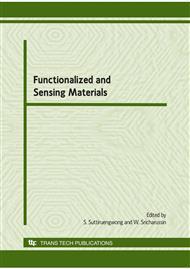p.639
p.643
p.647
p.651
p.655
p.659
p.664
p.668
p.672
β-Crystal Development of Isotactic Polypropylene during Sheet Extrusion Process
Abstract:
The objective of this study is to correlate the crystal structure with material and processing parameters, in particular -nucleating agent and degree of supercooling. The selected -nucleating agent used in this study was “Quinacridone pigment, E3B” with concentration varied from 1 to 100 ppm. The degree of supercooling during sheet extrusion process was controlled by chill roll temperatures in a range of 60 to 115oC. Crystal structures in neat PP and PP-E3B samples were characterized using WAXD and DSC techniques. The selected PP-E3B, with optimum concentration of 5 ppm, was fabricated into sheets using chill roll temperatures of 60, 70, 80, 90, 100, 110 and 115oC; these sheets had -crystal content (K-value) of about 0.099, 0.214, 0.341, 0.430, 0.651, 0.754 and 0.892, respectively. The melting characteristics and physical properties of the nucleated iPP were also dependent upon -crystal content. Finally, it could be concluded that the development of -crystal structure was highly influenced by the concentration of nucleating agent and processing conditions during sheet extrusion.
Info:
Periodical:
Pages:
655-658
Citation:
Online since:
January 2010
Keywords:
Price:
Сopyright:
© 2010 Trans Tech Publications Ltd. All Rights Reserved
Share:
Citation:


